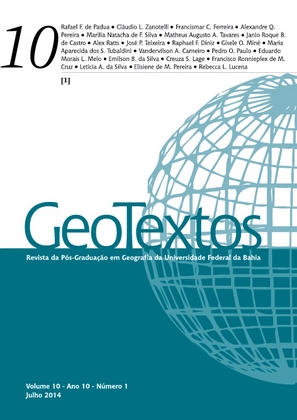BRAZIL’S NORTHEASTERN COAST AND THE ESTATE-TOURISM: BAHIA, PERNAMBUCO, CEARÁ AND RIO GRANDE DO NORTE
DOI:
https://doi.org/10.9771/1984-5537geo.v10i1.9951Keywords:
Tourism, Coastal areas, Northeast regionAbstract
The Northeast region of Brazil had its tourist preponderance planned in the last decade of the twentieth century. Before that time, the regional public policies did not see tourism as a strategic and developmental activity in Brazil and also did not evaluate the impacts arising from the real estate deals proper for summer vacation. In this paper, we propose an investigation on the diffusion models and ideas about the global and local tourism and summer vocations activities in coastal areas, focusing on the coast of the Northeastern region of Brazil. The territorial arrangement promoted by the construction of tourist-estate on the coast of Bahia, Ceará, Pernambuco and Rio Grande do Norte were the focus of the research, as they are the largest recipients of these types of properties for leisure. Regarding the Methodologly, the study was conducted in three stages: bibliographical survey, secondary data analysis, along with the right public bodies and the preparation of cartograms that enabled the understanding of logical installation of these projects in the main cities of the Northeast region. The coast designed as recreational space is a spatiality predominantly in the main cities of the Northeast region of Brazil. There are leasing investments in non-metropolitan centers, however, the metropolitan perimeters are the ones that consolidate large private estate projects regarding on the new demands facing the tourists demands.Downloads
Downloads
Published
How to Cite
Issue
Section
License
Autores que publicam nesta revista concordam com os seguintes termos:
Autores mantém os direitos autorais e concedem à revista o direito de primeira publicação, com o artigo simultaneamente licenciado sob a Licença Creative Commons Creative Commons CC BY que permite o compartilhamento do trabalho com reconhecimento da autoria e publicação inicial nesta revista. Esta licença permite que outros distribuam, remixem, adaptem e criem a partir do seu trabalho, mesmo para fins comerciais, desde que lhe atribuam o devido crédito pela criação original. É a licença mais flexível de todas as licenças disponíveis. É recomendada para maximizar a disseminação e uso dos materiais licenciados. Ver o resumo da licença em: https://creativecommons.org/licenses/by/4.0/ Ver o texto legal da licença em: https://creativecommons.org/licenses/by/4.0/ Consulte o site do Creative Commons: https://creativecommons.org/licenses/?lang=pt
Autores têm autorização para assumir contratos adicionais separadamente, para distribuição não-exclusiva da versão do trabalho publicada nesta revista (ex.: publicar em repositório institucional ou como capítulo de livro), com reconhecimento de autoria e publicação inicial nesta revista.
Autores têm permissão e são estimulados a publicar e distribuir seu trabalho online (ex.: em repositórios institucionais ou na sua página pessoal) a qualquer ponto antes ou durante o processo editorial, já que isso pode gerar alterações produtivas, bem como aumentar o impacto e a citação do trabalho publicado (Veja O Efeito do Acesso Livre).










